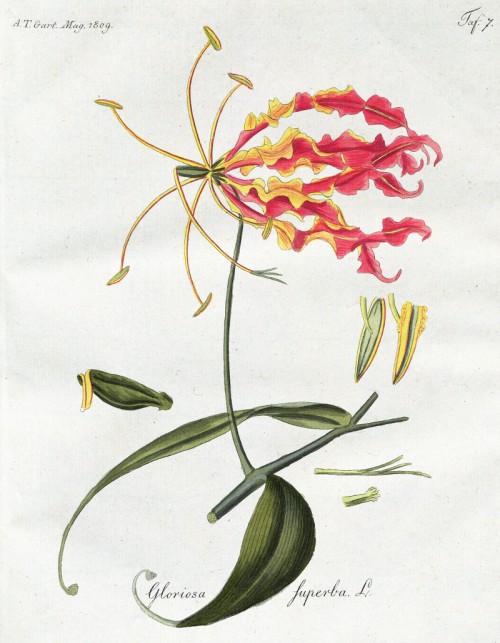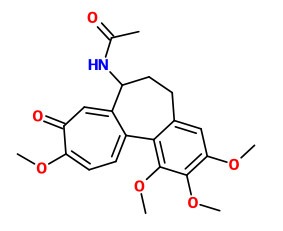Gloriosa superba L. - syn.Gloriosa simplex L.; Gloriosa virescens Lindley - Liliaceae (Colchicaceae)
glory lilly, climbing lilly, flame lilly, Ruhmeskrone
Herbaceous branching climber, up to 3m long, native to tropical Africa, India, naturalized and cultivated elsewhere; leaves up to 15cm long, sessile or nearly sessile, ovate-lanceolate, glossy, acuminate, tip ending in a tendril; flowers solitary, large, axillary, nodding, variable colored from orange-scarlet to crimson, petal margins crispy-waved; spreading filaments 3-4cm long, anthers about 1cm long.
http://www.efloras.org/florataxon.aspx?flora_id=2&taxon_id=200027670
Drugs prepared of colchicine or colchicine containing herbs like G.superba are effective against gout, but also toxic.
„The clinical features of colchicine toxicity in a patient following ingestion of Gloriosa superba tubers are described. Gastroenteritis, acute renal failure, cardiotoxicity and haematological abnormalities were the main toxic manifestations. There was no hypotension and no neurological manifestations. Electrocardiographic changes were noteworthy and have not been reported previously.“
[Colchicine cardiotoxicity following ingestion of Gloriosa superba tubers., Mendis, S., Postgraduate medical journal, 65(768), 1989, 752-755]
The levels of colchicine determined in six different species of Gloriosa by extraction with petroleum ether and dichloromethane revealed that, Gloriosa planti tubers exhibited the highest value of colchicine (0.34 mg/g), followed by Gloriosa lutea (0.29), Gloriosa casuariana (0.24) and Gloriosa superba (0.21 mg/g).
[Estimation of colchicine in six different species of Gloriosa grown in vivo., Bharathi, P., Philomina, D., Chakkaravarthi, S., Indian journal of pharmaceutical sciences, 68(6), 2006, 806] http://www.ijpsonline.com/article.asp?issn=0250-474X;year=2006;volume=68;issue=6;spage=806;epage=809;aulast=Bharathi
„Gloriosa superba L. is a perennial climber andisused as an ayurvedic medicinal herb to cure diseases in various parts of Africa and Southeast Asia. The plant was under threatened category due to its imprudent harvesting from wild as it is extensively used by medicinal industries for its colchicine content. It also faces a low seed set problem, but due to its industrial demand it is now under cultivation. The plant is used to cure arthritis, gout, rheumatism, in flammation, ulcers, bleeding piles, skin diseases, leprosy, impotency, snakebites, etc. Various compounds have been isolated from the plant parts mainly tubers and seeds, viz colchicine, colchicoside (its semi-synthetic derivative is thiocolchicoside), superbine, gloriosine, lumicolchicine, 3-demethyl-N-deformyl-N-deacetylcolchicine, 3-demethylcolchicine, N-formyl deacetylcolchicine.“
[Critical review on medicinally potent plant species: Gloriosa superba., Jana, S., Shekhawat, G.S., Fitoterapia, 82(3), 2011, 293-301]
The colchicine content in G.superbatubers ranged from 0.1% to 0.5%. and was invariably found higher in cultivated tubers than their wild counter parts.
[Basak, U. C., Dash, D., & Mahapatra, A. K. Estimation of Colchicine in Tubers of Gloriosa superba L. Originated From Different Agroclimatic Zones of Odisha, India, International Journal of Pharmacognosy and Phytochemical Research, 2012, 157-161] http://ijppr.com/PDF%20all%20edtions%20IJPPR/Vol4/Issue3/IJPPR,Vol4,Issue3,Article18.pdf

Allgemeines teutsches Garten-Magazin, vol.6 t.7 (1809)
http://plantgenera.org/species.php?id_species=468956

